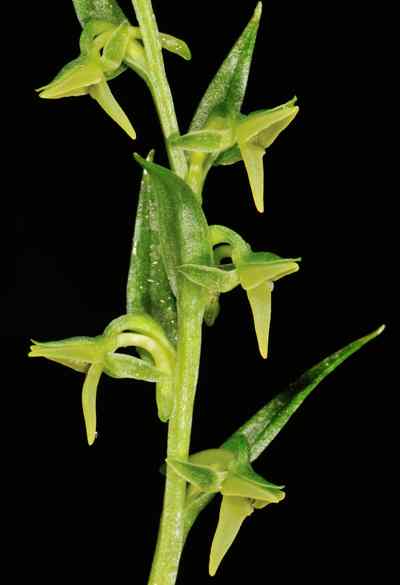The Plant
Terrestrial. An annular herb of about 8 to 12 cm in height from the alpine slopes. Stem and peduncle pubescent, with the former smaller in length than the former. Stem clothed at its base with 2 to 3 unequal tubular sheaths. Leaves 3 or 4, almost alternate in arranged, unequal with the lowest the smallest, ovate to elliptic, sessile with clasping base and pointed apex, 0.75 to 3.5 cm long and 0.5 to 3 cm in width, 5 to 7 strong veins and several narrow veins in between them, both the surface and its margins minutely hairy. Flower solitary at the apex of the erect peduncle.
The Flower
Flower large, 2 to 3 cm across. Sepals unequal; dorsal sepal ovate, acute, diagonally arching, laxly pubescent; lateral pair united under the lip, broadly ovate. Petals longer than the dorsal sepal, lanceolate, diagonally spreading with its apex curved forward, inner surface with many long white hairs to its base, margins pubescent. Lip saccate, diagonally pendulous, rotund in outline. Floral bract longer than that of the flower, lanceolate, arching diagonally over the dorsal sepal, arising from behind the arched short ovary, puberulosus, many veined.
The outer surface of both sepals and petals are pale brown with many darker veins and markings running all along its length; their inner surface pale brown with many irregular broken streaks and markings of dark brown paler than that of its outer surface. Lip brown but covered almost with bright reddish to purplish shade. Floral bract bright green.

The Pursuit
A plant of the high Himalayan slopes and open dry areas. Not as rare as its counter parts. I missed this species for two continuous seasons. In the third year of my alpine work, I was staying with a very good friend of mine at the highest village of North Sikkim. He was assigned with building the highest hydro power station of the country there. He was an ardent lover of flowers and lead many expeditions in the various sectors of Himalayas and was lucky enough to spot this plant few years back from the region. That year too it bloomed in the same location and he guided me to there to see it in bloom.
But my deep desire to find it from a new location prompted me to undertake difficult treks on mountain slopes. Around 14,000 ft, there are stretches of high mountains towering to above 17,000 ft in height. There are many thousand floral plants up to its two third height, the rest height is devoid of any floral growth other than rocky surface. I had climbed up to its summit several times in search of many plants. A week after I photographed this species from the location my good friend showed me, I decided to search for the species again in those high mountains at higher elevations. On the fifth day of the search, I was taking a deep ascent of those high mountains from its southern side. It was very steep and hard to negotiate. I was forced to lie down and crawl up between various spots. After a steep climb I reached a flat place which was full with blooming Iris.It was very beautiful and was taking few photographs of it. A strong wind came from the northerly direction and took my cap away. The wind threw the cap to the other side of the flattened surface. Leaving my camera and other accessories behind I tried to take back my cap which was stuck to a small Rhododendron plant on the steep side of the hill. As there were many such plants I know I will got skid down the mountain and I sat there and slowly moved on my back to reach the cap and collected it back. As I was crawling back I found something very bright coloured under that Rhododendron plant. Not one second was needed for identifying a plant like this that also when it is in bloom. I was very much satisfied with the find, but to document it on that steep slope needed for logistics. I returned to my base camp and arranged ropes and other necessary things for next days trip.
Unfortunately I haven’t got any porters to carry the ropes up the mountain and made two trips to make those heavy weighted ropes and my camera accessories reach the spot. By fixing the rope to a few Rhododendron plants and the other end rigidly on me I went down the slope and crawled under the other plant to reach the species and with much difficulty produced this photograph. I was interested in back lighting the plant to get some more details made the thing little more complicated. One flash light I fixed behind the flower rolled further down hill and disappeared inside the Rhododendron thickets. It was an expensive accessory and I wanted it back at any risk. The rope I was using was not so long for reaching any further down also. Suddenly, out of blue, a local villager appeared there. He was there to collect some herbs used for making herbal tea. I told him the unfortunate incident and he with much ease went down hill without even holding or taking support of the rope and searched the whole area and brought my flash back. Then he also encountered this species. Then came the most unfortunate incident, he puled out the whole plant from there even before I can stop him. He wanted to plant it in his home. I was sure it will not survive in his home and my find of another location of the species went in vain. I still hope on that slope there will be some more plant of this species.
Reference:
King, G. & Pantling, R. (1898). The Orchids of the Sikkim-Himalayas. Ann. Roy. Bot. Garden. (Calcutta). Cypripedium himalaicum Rolfe., Page no 342.








